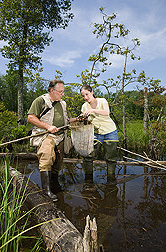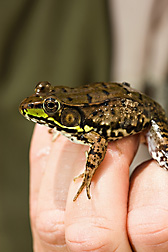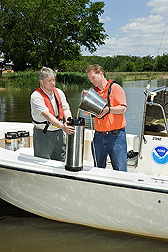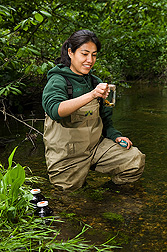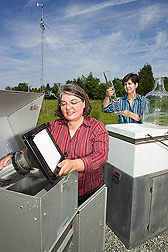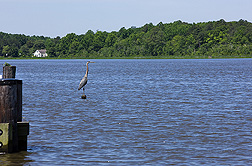ARS Chesapeake Bay Research Intensifies
The Chesapeake Bay faces many threats—from the pesticides and fertilizers used to grow corn, soybeans, and other crops, to pollution from wastewater-treatment plants, cars and boats, and poultry production.
Agricultural Research Service scientists have contributed to the effort to clean up the bay for more than two decades. Most recently, ARS scientists in Beltsville, Maryland, conducted a comprehensive study of pollutants at seven spots in the Choptank River, a major bay tributary that faces the same threats.
Traveling in a research vessel, they collected water samples at each stop. They later analyzed these samples for salinity, temperature, dissolved oxygen, chlorophyll, phosphorus, nitrogen, arsenic, copper, and the herbicides atrazine, simazine, and metolachlor and their degradation products.
Sampling a Bay Tributary
The U.S. Geological Survey (USGS) established some of these sampling sites in 1975, providing long-term data for reference. The U.S. Environmental Protection Agency (EPA) also has water-quality monitoring stations in the Choptank that date back even earlier.
This study was done as part of the Conservation Effects Assessment Project (CEAP) for the Choptank River Watershed. CEAP began in 2004 and now involves 37 watersheds nationally. CEAP focuses on the effects of USDA conservation practices and Farm Bill conservation programs.
The long-standing regional goal of cleaning the bay is an additional incentive for success in the CEAP Choptank program, resulting in a network of organizations ready to use ARS’s research results. (See list of organizations at the end of this article.) It also provides an established scientific infrastructure, such as the USGS and EPA samplings sites, to support research.
Monitoring the Choptank provides needed information on the dynamics of the bay watershed. This information helps develop new conservation practices or refine existing ones.
Sampling every 2 months from March 2005 through April 2008, the ARS scientists and their colleagues found that nitrate concentrations, which were highest in winter, often exceeded levels that can cause algal blooms. Algal blooms can deplete dissolved oxygen concentrations in the river, killing aquatic organisms such as fish and shellfish. Nitrate levels were highest at the headwaters where farming is concentrated, suggesting that agricultural fertilizers, including manure and poultry litter, are the primary sources of the nitrate.
In contrast, phosphorus concentrations were similar throughout the length of the river, suggesting multiple sources of this nutrient. While some evidence points to wastewater treatment plants as a likely primary source, agriculture is also a major contributor of phosphorus to the bay.
Elevated copper concentrations were found in almost all samples at the lower reaches of the Choptank, but not in the upstream areas.
“This suggests that copper loss from antifouling boat paint is the primary source of the copper, rather than agriculture,” says Dean Hively, a visiting physical scientist from the USGS Eastern Geographic Science Center. “The levels were high enough to be toxic to clams and other aquatic invertebrates that help feed and filter the bay.”
|
|
To the Bay: Above- and Below-Ground Routes
Herbicides and their breakdown products were present year-round throughout the study, says Cathleen Hapeman, a chemist at the ARS Environmental Management and Byproducts Utilization Laboratory (EMBUL) in Beltsville, Maryland. Herbicide concentrations peaked after springtime applications. While herbicides and phosphorus travel to the Choptank mainly via surface water flow, herbicide breakdown products and nitrates flow mainly via groundwater.
“The concentrations of herbicides we observed did not approach established levels of concern for aquatic organisms,” Hapeman says. “Still, this research shows the importance of agricultural practices that reduce herbicide losses from springtime applications in particular.”
A Clear View of the Bay
“The Choptank water sampling gives us a baseline against which to compare future changes in water quality,” Hapeman says. “It may also be used to design programs to monitor the effectiveness of restoration efforts. Simultaneous measurement of multiple water-quality variables and contaminant concentrations is important to creating a clear picture of the main water-quality problems and dynamics within Chesapeake Bay tributaries.”
ARS soil scientist Greg McCarty says that the overall goal of the Choptank CEAP research is to “develop a set of measurement and modeling tools for assessing the effectiveness of commonly used conservation practices at a watershed scale. We use remote-sensing techniques to broaden measurements of the effectiveness of practices from one field to the entire watershed. We also do this with another technique we developed to evaluate winter cover crop effectiveness.” (See “Chesapeake Bay Cleanup Revs Up!” in this issue.)
|
|
In another CEAP Choptank study, McCarty, Hapeman, and colleagues monitored levels of nitrogen, phosphorus, atrazine, and metolachlor within 15 small agricultural and forested subwatersheds of the Choptank to gain a more detailed assessment of land use and conservation practices on water quality. For comparison, they periodically sampled lower portions of the river that are not bordered primarily by agricultural land.
McCarty and ARS chemist Laura McConnell are the principal investigators for the Choptank project, working with Hapeman, ARS soil physicist Ali Sadeghi, Hively, USDA Forest Service ecologist Megan Lang, ARS agronomist Eton Codling, and ARS chemists Clifford Rice and Krystyna Bialek.
McCarty, Sadeghi, Hively, and Lang are at the ARS Hydrology and Remote Sensing Laboratory in Beltsville, Maryland. McConnell, Hapeman, Rice, Bialek, and Codling are with EMBUL.
Forests, Wetlands Vital to Bay’s Health
In studying nutrient and herbicide flows from the 15 subwatersheds, McCarty says, “We have discovered that watersheds with more forests or wetlands export less nitrate to the river.” Forests and wetlands naturally slow the movement of water on the land, allowing nature to process nitrate. “This area of the bay has historically been drained by ditches, which short-circuit these natural filters within the landscape,” McCarty says. “Farmers can use drainage-control strategies to slow the movement of water from their fields, thereby restoring some of the filtering capacity of the land. A combination of riparian buffers, wetlands, and controlled drainage management are needed to mitigate nutrient pollution.”
|
|
Nation’s Testing Ground
ARS is also working on CEAP’s recently developed Mid-Atlantic wetlands study, which incorporates ARS research on wetlands in the Choptank’s watershed. The effort involves ARS laboratories in Beltsville; University Park, Pennsylvania; and Florence, South Carolina. It focuses on wetland benefits in the New Jersey, Delaware, Maryland, Virginia, and North Carolina Coastal Plain. The Mid-Atlantic project provides a testing ground for a national program of monitoring wetlands to evaluate and sustain or improve their benefits to society and the environment.
“Like all CEAP projects,” Lang says, “one goal of the wetlands study is to develop collaborations to deliver research results for better practices. The results inform conservation decisions affecting wetland ecosystems and the services they provide, such as pollution control,” she says.
Through the Choptank wetland study, Lang found that using radar sensors aboard satellites provided a way to detect water flows in forested wetlands. (See “Forested Wetlands in the Chesapeake Bay Watershed” in this issue.) Through this CEAP wetland study, new techniques have been developed to map and monitor wetlands. These techniques are currently being explored for possible incorporation into operational programs by multiple federal and state agencies. Lang is now working with the Maryland Natural Resources Conservation Service to use these techniques to monitor the success of large forested wetland restorations and encourage the restoration of more wetlands.
|
|
To the Bay: By Air
Newer CEAP Choptank studies are looking at how the interplay of agriculture and urban areas affects carbon storage, wildlife habitat, and air quality.
For example, McConnell leads a new air-quality study that is the first to examine several types of farm emissions—ammonia; active ingredients in pesticides; volatile organic compounds from crops, solvents, and other pesticide ingredients; and dust—and their interactions with urban pollutants across the bay watershed.
McConnell, Hapeman, Rice, and colleagues at the University of Maryland-College Park are developing new techniques for tracking agricultural airborne particles by their chemical fingerprints.
The vastness of the bay’s watershed makes the task of halting the bay’s decline even more of a challenge. Growing urbanization makes it essential to implement practices in coming years that ensure that urban and rural communities work together to lower rather than increase pollution risks.—By Don Comis, Agricultural Research Service Information Staff.
• Maryland Department of Agriculture
• University of Maryland-Wye Research and Education Center
• University of Maryland Center for Environmental Science
• Smithsonian Environmental Research Center
• USDA’s Natural Resources Conservation Service
• National Oceanic and Atmospheric Administration
• USGS Eastern Geographic Science Center
• USDA’s Forest Service
• Queen Anne’s, Talbot, and Caroline County Soil Conservation District Offices
• Local farmers
This research is part of Manure and Byproduct Utilization (#206), Soil Resource Management (#202), Water Availability and Watershed Management (#211), and Climate Change, Soils, and Emissions (#212) four ARS national programs described at www.nps.ars.usda.gov.
To reach scientists mentioned in this article, contact Don Comis, USDA-ARS Information Staff, 5601 Sunnyside Ave., Beltsville, MD 20705-5129; (301) 504-1625.
"ARS Chesapeake Bay Research Intensifies" was published in the August 2010 issue of Agricultural Research magazine.







